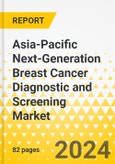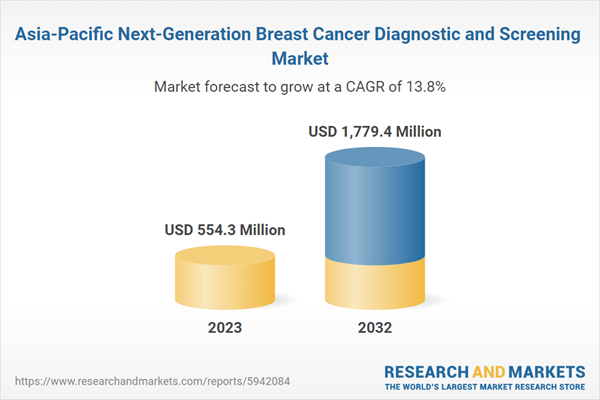10% Free customization
The Asia-Pacific next-generation breast cancer diagnostic and screening market was valued at $554.3 million in 2023 and is anticipated to reach $1,779.4 million by 2032. The anticipated growth in the next-generation breast cancer diagnostic and screening market is projected to be fueled by several factors. These include the uptick in the occurrence of breast cancer cases, heightened awareness concerning early detection of breast cancer, a growing emphasis on breast cancer biomarkers for improved screening, prognosis, and tailored treatment, as well as the escalation in partnerships and collaborations among industry participants. This report comes with 10% free customization, enabling you to add data that meets your specific business needs.
Market Introduction
The Asia-Pacific (APAC) region anticipates significant growth in the next-generation breast cancer diagnostic and screening market. This growth is propelled by various factors, including the increasing incidence of breast cancer cases in the region. Heightened awareness campaigns focusing on early detection and screening contribute to this surge. Additionally, there's a growing emphasis on utilizing breast cancer biomarkers for more effective screening, prognosis, and personalized treatment strategies. Moreover, the collaborative efforts and partnerships among market players further drive advancements in diagnostic technologies and screening methodologies. With these dynamics in play, the APAC next-generation breast cancer diagnostic and screening market presents promising opportunities for improved breast cancer management and outcomes across the region.Market Segmentation:
Segmentation 1: by Country
- Japan
- China
- India
- Australia
- South Korea
- Singapore
- Rest-of-Asia-Pacific
How Can This Report Add Value to an Organization?
Growth/Marketing Strategy: The APAC next-generation breast cancer diagnostic and screening market has seen major development by key players operating in the market, such as business expansions, partnerships, collaborations, mergers and acquisitions, product launches, and funding activities. Partnerships, alliances, and business expansions accounted for the maximum number of key developments in the APAC next-generation breast cancer diagnostic and screening market, followed by regulatory and legal activities and mergers and acquisitions.Competitive Strategy: Key players in the APAC next-generation breast cancer diagnostic and screening market analyzed and profiled in the study involve players that offer next-generation breast cancer diagnostic and screening products and services. Moreover, comprehensive competitive strategies such as partnerships, agreements, collaborations, product launches and approvals, and funding scenarios will aid the reader in understanding the untapped revenue pockets in the market.
This product will be delivered within 3-5 business days.
Table of Contents
Executive SummaryScope of the StudyResearch Methodology
1 Oncology Molecular Diagnostic Market
2 Next-Generation Breast Cancer Diagnostic and Screening Market
3 Industry Outlook
4 Regions
5 Markets - Competitive Benchmarking
List of Figures
List of Tables
Companies Mentioned
- BGI Genomics Co., Ltd.
Table Information
| Report Attribute | Details |
|---|---|
| No. of Pages | 82 |
| Published | February 2024 |
| Forecast Period | 2023 - 2032 |
| Estimated Market Value ( USD | $ 554.3 Million |
| Forecasted Market Value ( USD | $ 1779.4 Million |
| Compound Annual Growth Rate | 13.8% |
| Regions Covered | Asia Pacific |









